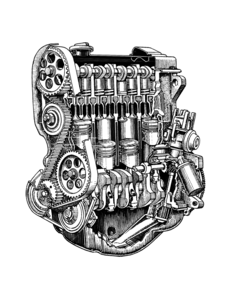TECH TIP: THE BRAKE JOB
There is no higher profit job for a muffler chain shop than a front brake job. A brake job with disc brakes is faster and easier for the repair shop than a drum brake job but they charge extra for it. Do it yourself and save.

The brakes on a VW have two parts: a hydraulic system, and the brake shoes and pads. When you step on the brakes, the pedal pushes a piston in the master cylinder. This action compresses the fluid evenly to all four wheels where there is a cylinder (caliper or wheel cylinder) that moves the pads or shoes and causes the wheel to stop. For safety this hydraulic system is dual; the master cylinder is really two; one pushes the right front and the left rear. In case there is an interruption in one of the hydraulic systems, there are still enough brakes to stop the car.
Ordinarily, maintenance consists of checking the fluid level and inspecting the wear of the brake shoes and pads. From 1979 on, the rear shoes are self-adjusting and the earlier models adjust like the Beetle, a star that you turn to center the shoes closer to the drum. You can do this yourself with a just a screwdriver. If your pedal starts feeling spongy, now is the time to isolate and correct the problem. Don't drive with a situation that could deteriorate from bad to disastrous.
Always bleed the brakes first; this could be your whole problem. Bleeding the brakes is simply getting the air out of the hydraulic system. Check all the lines and hoses for leaks. That eliminates everything except the master cylinder and the brake servo (if your model has one). Read the manuals and analyze what you have. Don't do half a job; while you have things apart replace parts that look marginal, so you don't have to do this job again. Another of those good preventive chores you can do is to flush the brake system every couple of years with new brake fluid. This keeps water and rust from damaging parts.
For most VW vehicles we have new, remanufactured and recycled calipers. The new calipers can come with or without clips, pins and pads--it varies. They are not available in all cases. The "best buys" are the remanufactured. These are done by a brake specialist who disassembles, cleans, flushes-out, and replaces the unit with new seals and bleeders reassembled for easy installation. (Pins, carriers, plates, etc., are generally reused.) Pads are sold separately. Our recycled calipers have good, freely-moving bleeders, (NO BROKEN ONES) and ready to use. Generally, they have pins, pads, carriers, etc., but the pads are not guaranteed.
WARNING: While our customers have found this information useful, these articles/links are not from technical publications. Information presented here is to give you a general idea of what to do and how to do it. Auto repair, while fun and economical, can be dangerous. There is no way we can warn you of each and every hazard. How can we tell you that when installing a hub cap, don't smoke and have a bucket of gas nearby? If you have no common sense, ignore these articles. Otherwise, read the warnings in the front of the Robert Bentley manual before you proceeded to follow any advice given here.




